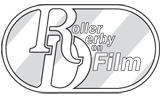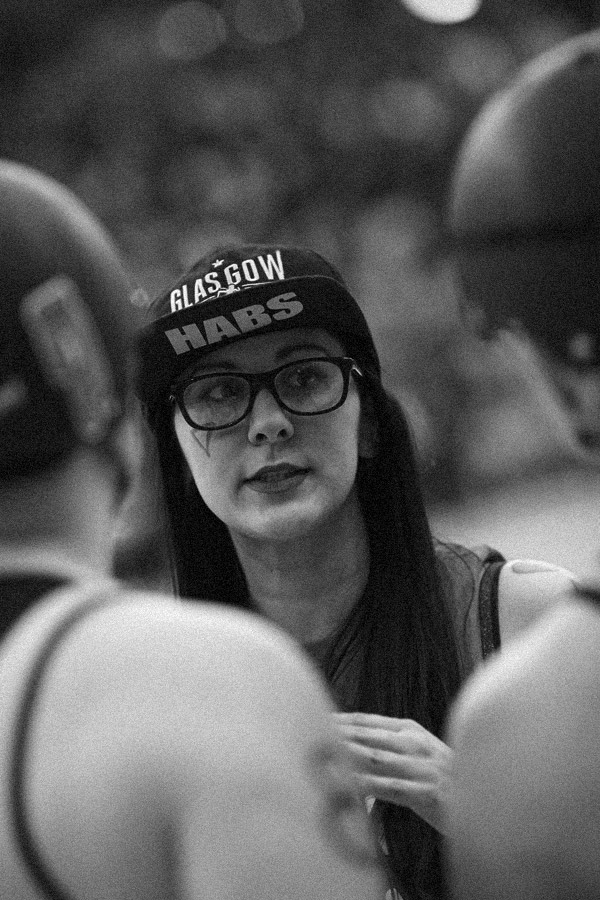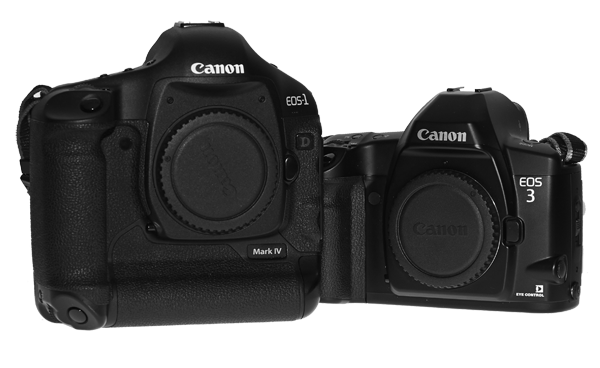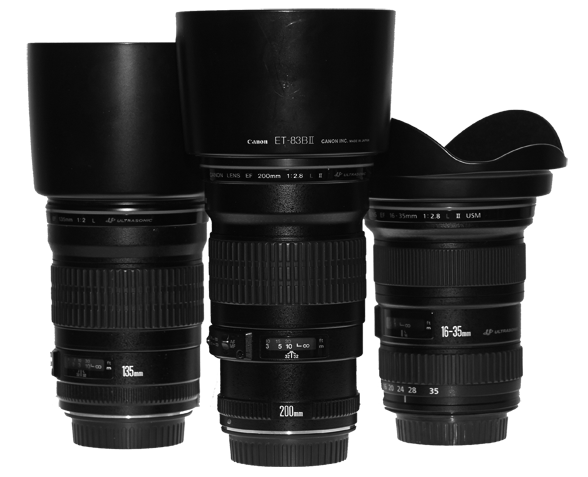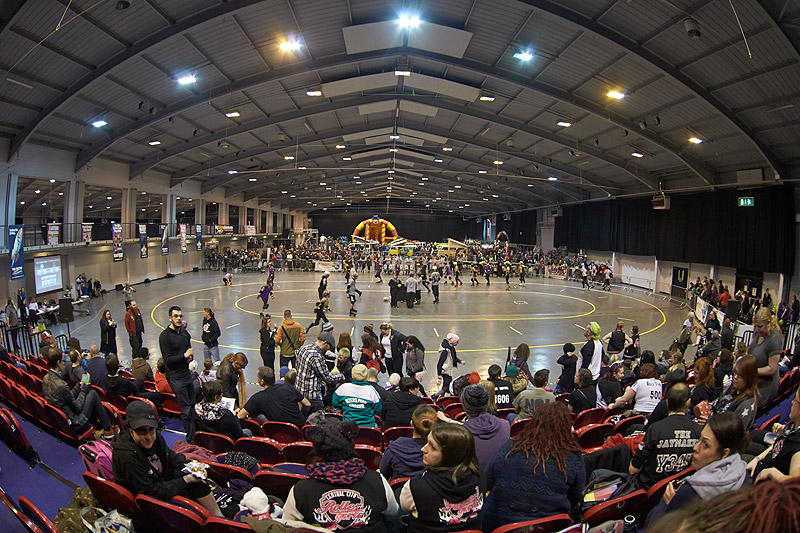Photographing Roller Derby - Tips
The following ramble has been pieced together from my own experience and what I’ve learned from sports photographers and other sources. It is by no means comprehensive or suit your style, but hopefully it’ll be helpful to those starting off shooting, what is, due to circumstances, a difficult sport to cover. Once you have been to a couple of bouts you will have a better idea of the game and where to position yourself to get the best images.
Before I get on to equipment the first thing to do is to contact the home team about covering their bout. Usually they'll have no problems and welcome someone taking an interest. They may have a policy for dealing with the media. This is usually along the lines of free entrance and access to all areas in return for a copy of the images for their records. I know some photographers have issues of giving out hi-res copies (for copyright issues) as they cannot control their use. A compromise would be to offer the team a set of lo-res web images for their personal use. I personally do not have an issue with giving images away and freely distribute hi-res copies (I will be slapped by every professional photographer at this point). The sport is still, in most regions, in its infancy. Everyone is an amateur pursuing their interest. Many teams are run on the subs of their members. Any profits made from bouts being ploughed back in to kit and putting on more events. As such they are in no position to afford professional photographic services. There is, in photographic terms no money to be made out of it. As such the images I shoot have no monetary value. I shoot it because I enjoy it and I feel that at present it is how it should be approached. Being helpful and offering copies of the images will usually result in an invite back. The more you get to know the teams the more you'll get back.
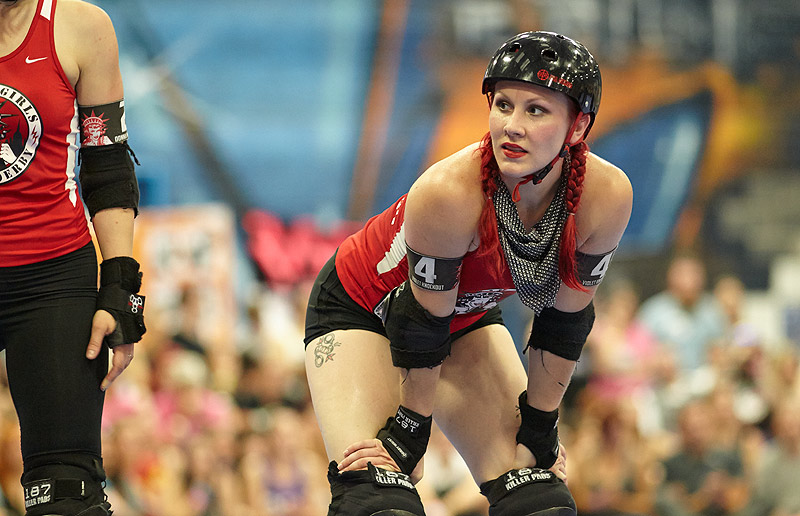
London Rollergirls vs Gotham, Leeds 2014
A greater number of quality images out there will hopefully generate more interest in the sport. More interest equals more fans, more fans equals more money, and maybe, just maybe, one day, that may mean a pay cheque.
Equipment
Most digital DSLRs (Single Lens Reflex) should be up to the job of delivering reasonable results. For me it is the lens that counts. A decent lens will save your life and get you that shot. If you’re working commercially it’s a must. When shooting sports you ideally need to be shooting at around 1/500th of a second to freeze the action. A fast lens, f2.8 or greater will also mean that you can blur the background and allow you isolate the subject.
Over the past few years I have learnt a hell of a lot. I used to pack loads of gear but now I travel light. I've got used to the lighting conditions of the venues and am pretty confident of getting decent shots in almost any light. If I get to a venue and there's decent natural light it's a bonus.
When shooting with a telephoto lens the rule of thumb is that you should be using a shutter speed that is twice the speed of the focal length to eliminate camera shake. Therefore with a 200mm lens one should be shooting at least 1/400th second, ideally faster. I try to stick to 1/500th second as a minimum.
So what’s in my bag, apart from the sandwiches. This is what I would pack for a tournament, I may take less for individual bouts. In brackets are my favoured alternatives if I was going to replace a lens.
- Cameras x 3 - 1dx, 1dx mkII and Fuji X100S
- Lens - Canon 200mm II f2.8
- Lens - Canon 135mm f2 - I’d have second if could find one cheap second-hand
- Lens - Sigma 35mm f1.4 - This is my new go to wide-angle, not too wide and pin sharp
- Lens - Sigma 24mm f1.4
- Lens - Zeiss 15mm f2.8
- Extender - 1.4x exII (1.4 exIII) - Useful if you are in a venue and you need that extra bit of reach
- Light meter
- Spare batteries
- Memory cards. I used to carry around lots of smaller cards 4gb/8gb but as file sizes require bigger cards and my confidence in their robustness has increased I now mainly use 64gb/32gb/16gb cards (Lexar/Sandisk). I still keep the old cards to hand just in case, and during tournaments such as the World Cup, that extra storage space can be a godsend.
- Notebook and pen (to take notes, contact details etc...)
- Food and water, there’s nothing worse than shooting on an empty stomach (or a lacky to buy coffee)
First up, camera bodies. Most modern DSLR bodies should be up to the job, they have evolved considerably over the past few years. Focussing in low light and frame rate is what is needed. High pixel count less so, but it helps for cropping for final composition. But higher pixel counts comes at a cost of longer processing speeds. It all depends on what you are trying to capture and what else you want to use it for. Noise at high ISOs have been dramatically improved so don’t worry about bumping this up to the level you deem acceptable to get a high enough shutter speed.
I also now pack a Fuji X100S (picked up 2nd hand). Set to black and white it gives me a bit more freedom at half-time to get candid shots. A great camera to slip in to your pocket and take anywhere.
Lens of choice for me is the Canon 135mm f2. Sharp at f2 and razor sharp at f2.8 it also focus's quick. It's light for hand holding and as it's black it gets a lot less attention than the larger white Canon lenses. A prime lens means you'll have to use your legs as the zoom. But hey, everyone could do with some exercise. However, if you're sitting on the side lines and don't have access to move about it can be an issue.
I now also pack the Canon 200mm f2.8 II. Another great, sharp lens, that’s cheap in ‘L’ lens terms and can usually be picked up second-hand for a steal. It is also light and balances on a body well. This lens combined with the 135mm provides me all I need in terms of action on track. I get a lot of my gear from mpbphotographic.com. I’m quite happy to buy 2nd hand lenses and many seem to have had little, if any use.
Next up is a wide angle for group shots. I used to use the Canon 16-35mm f2.8. I traded up from the 17-40mm f4. Was it worth the money? Probably not. If I was buying a wide angle zoom lens now it'd be the Canon 16-35mm f4 IS. Cheaper and sharper and with Image Stabilisation. However I have switched to Sigma wide angle primes as I'm not a fan of zoom lenses. I used to shoot with Sigma lenses with my old Pentax set up but was never convinced by them but the new crop of 'Art' lenses are outstanding. The Sigma 35mm f1.4 is my go to wide angle and like the Canon primes I don't miss the abilty to zoom. I am able to walk backwards and forwards. I also pack a 24mm and for those few times when one may need to go ultra wide, a Zeiss 15mm. I picked this lens up second-hand and while not essential it gives me some more creative options.
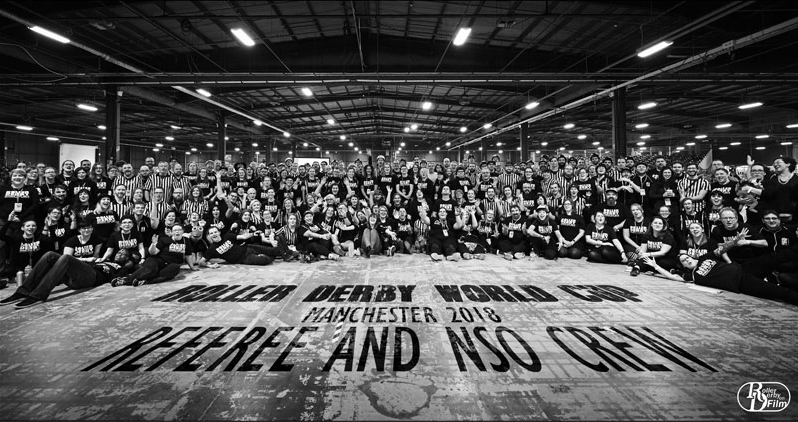
This group shot was taken on the Zeiss Distagon 15mm. Sometimes you need to go ultra-wide to get the shot.
I will also chuck in the bag a 1.4 extender to get those candid shots that are impossible without intruding on people’s personal space. On a crop camera the 200mm works out at around 280mm and with the extender, 392mm. It’s nice to have the extra reach at times. I do miss having a crop body at times.
The more you can spend on a lens usually equates to better images. Decent lenses, unlike camera bodies retain their value better on the 2nd hand market. If you have invested and find yourself strapped for cash you can always hock them. If you are thinking of investing in a lens for sports and are umming and arrring over a cheaper and more expensive model, buy the more expensive if you can. You may save a few pennies on buying the cheaper lens but I guarantee that you’ll be back down that camera shop in six months’ time to buy the lens you really wanted. Again, been there, done that, much to the glee of my local camera store salesman. Actually, when I part-exchanged my 17-40mm I got more than I paid for it due to Canon‘s price increase, so it was a good investment.
If you can afford it I would recommend buying a light meter. It will give you a better reading than your cameras in-built sensor and allow you to take readings around the hall before the bout starts so that you can set your camera up. This is a must for me as I always shoot on manual. I just don't trust computers to do the job for me.
Once you get your eye in, I find it is far more reliable than any fancy computer. I also work in full-stops. This means I can calculate ISO, Aperture and Shutter in my head and set appropriately for the given situation.
I may also chuck in the bag a 50mm, just in case. The Canon 50mm f1.8 is cheap and nasty and if I drop it down the toilet I’m not going to worry. It’s light, so why not. I very rarely use it, but one day it may save my life. I may, depending on the venue, throw in a couple of old modified specials. A fish-eye for example. I’m not going to buy one specially for Derby but an old modified Zenitar fish-eye stopped down so it’s reasonably sharp can produce some interesting effects. With a screwdriver, files and some wet and dry paper I got it working on a full-frame camera. With the adaptor I can also use all of my old manual focus Pentax lenses (with a bit of a modification, a saw is useful here).
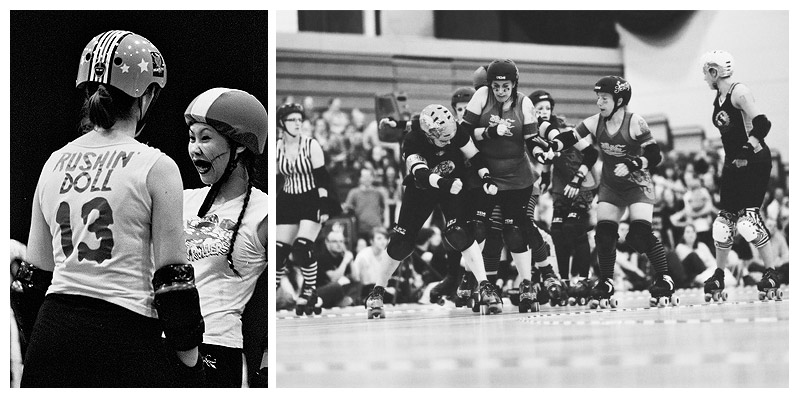
Image left, shot on a Pentax K1000, 50mm f2.8 lens on TMax 3200, Image right, shot on a Canon EOS3, 135mm f2 on Fuji Neopan 1600
While the above may be a wish list you can still get good results on a budget. I’ve shot some bouts on an old Pentax K1000 (1976) with a Vivitar 70-200mm f3.5 lens on Ilford Delta 3200. You could probably pick up the gear for less than £40 as manual film cameras are no longer in demand, then add another £5 for the film. It’s more hit and miss but if you are concentrating on the action on the periphery rather than on track it’s a good alternative. Even a decent film camera will only set you back £100 or so. I picked up an old Canon EOS3 (which is compatible with all my lenses) for £145. The downside is getting film stock. My film of choice was Fuji Neopan 1600, sadly no longer available and I think that’s it for 1600 film, so the only choice now is 800 or 3200 in 35mm.
I know people believe that film gain is more acceptable than digital noise. I feel this is a case of ‘rose-tinted glasses’. Modern DSLRs deliver cleaner images at high ISO comparable with film. Certainly it’s a different look, but better? I’m not convinced. It all depends what you are after.
Notebook and pen
Why would you want to carry around a notebook and pen? Isn't it 'old hat' technology? Making contacts is the best way to be invited to other bouts. Sure you can send teams a link once you’ve posted them all but making those personal contacts makes things so much easier. Like many hobbies that rely on Social Media to communicate, while it’s great for some aspects, it’s terrible for others; while it may be ‘Social’ it is very impersonal. If teams can put a face to a name and you’ve acted in a courteous and civil way with them at an event you start building up trust that can go a long way. An old fashioned notebook and pen gives you an excuse to talk to teams and get them to interact with you. Small gestures can have a big impact.
Flashes/Strobes - Should you, shouldn’t you?
I know a lot of people use flash/strobes nowadays. I don’t for plenty of reasons. Firstly, unless you have a good venue that complements flash photography I don’t like the look they give. Too many harsh shadows if not lit correctly, and that is usually difficult in a crowded venue. And if you have a good venue you probably don’t need flash/strobes in the first place.
Secondly, they limit your possibilities, forcing you to shoot where your flash is concentrated. If play shifts to an area you’ve not covered you’re sunk. It’s not always convenient or possible to move flash units mid way through a bout.
Thirdly, I personally feel that strobes distract skaters and fans. I have spoken to plenty of skaters who say they don’t, but if I get distracted and annoyed by them, I assume others do too. Very few sports allow flash. Then again most indoor sports, if set up for television are lit correctly so photographers don’t need to. It is a bit of a Catch 22 situation for Derby photographers.
I hadn’t realised I had so many issues with flash/strobes, so here’s my next beef. All those flashes need stands/clamps. More gear around the track to trip skaters/spectators. I do wonder how many photographers are insured in case a skater collides with some gear. I've seen too many precarious light stands, un-sandbagged, teetering with a hot flash head on them. Also people leaving gear in the ref lanes. Teams always seem more concerned about breaking photographic gear and less so with what a lens or a hot flash head (and they do get hot) could do to someone’s face (and I don’t mean a photo), which seems odd. Gear is replaceable. Scars are there for life and apart from those that give you bragging rights they aren’t usually pretty. Perhaps, I’ve been playing the health and safety role too long.
Finally, by the time I’ve bought all the strobes/flashes, stands, clamps wireless triggers, batteries etc… I could have gone out and purchased a decent fast lens. For me it’s a no brainer.
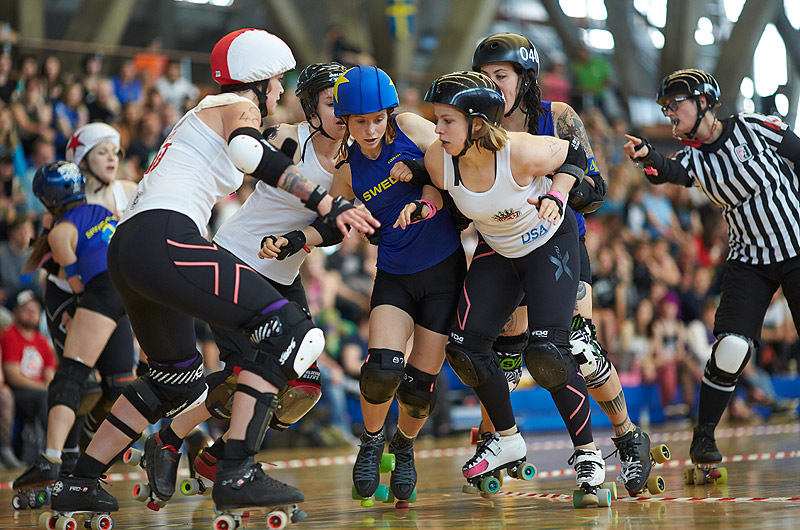
England Roller Derby vs Sweden - shooting bursts allows me to pick the optimum image in a sequence
And one more point. I like to shoot a burst of images (camera set on AI Servo on burst mode). This gives me a range of images to choose from in the final edit. The composition, expressions and the chance for capturing something unexpected is increased. With a strobe, once it has popped you have to wait for it to recycle for the next shot, chance lost.
I’ll stop ranting now.
Environment
Check out the location/hall before you arrive. This can be easily done on the internet as most sports centres will post picture of their facilities. While the images may not be good enough to orientate you within the room itself, they will give an idea about the lighting. Most sports hall seem to have uniform lighting, this by no means mean that it will be good, but from whatever angle you are shooting your camera settings should remain constant. I like to get to the location in good time so that I can take light readings around the room. This extra time will also allow you play around with your camera’s white balance. Shoot a few frames on each setting and then tweak everything to get the best result. The more you can get ‘in camera’ will mean less processing time later. It also allows you to meet up with your contact(s) and go through and do’s and don’ts the team imposes.
If your camera will allow it I would also shoot in RAW rather than Jpeg. RAW gives you more leeway in tweaking the image in post-production, which you will usually need due to the lighting. You should be able to adjust the exposure by +/- one stop without losing any image quality. It will also allow finer tuning of the white balance. The Photoshop RAW plugin supports most digital cameras but if you do not have Photoshop the software supplied with your camera should do the same job. I am a convert to Phase One’s, Capture One as it suits my workflow and has decreased the time I spend editing considerably. Less time on the computer means more time down pub.
The latest digital cameras allow you to crank up the ISO to ridiculous speeds. While this may seem a solution to the bad light, terrible lighting plus high ISO equals noise. If your shots are for screen use only this isn’t too much of a problem, by the time you reduce the image size, sharpen it and tweak the colour, even an out of focus shot can become useable. However for prints a shot must be crisp, in focus, have a good colour balance with as little noise as possible. A good quality printer will pick up any flaws in a shot. My rule of thumb is that if an image can’t withstand being reproduced at A3 size, it’s a dud. I try not to crank the ISO up over 1600 if possible, maybe to 3200 or 6400 on the latest high end cameras, but no more if possible. You need to decide on the level of quality you are after and set your camera appropriately.
Subject
Shooting in an environment with bad light will restrict the shots you’ll get. Having a shutter speed that’ll allow you to freeze the action is difficult in these circumstances unless the ISO is cranked all the way up, which in turn will add considerable noise. If you need to get something out of the afternoon go initially for safety shots. These are the shots you know you’ll get. A good one is the players lining up for a jam. The subject will be reasonably still and you can get some great expressions on the players faces as they work out tactics. Similarly the bench is also a good starting point. With these in the bag you can feel confident that if nothing else comes out you’ve got something. To get great shots will require time and luck. Ultimately, the more time spent shooting the luckier you will get. I tend to find that if one in ten shots is in focus I’m doing well, one in a hundred will be good, one in a thousand a cracker. To get that one ultimate shot, whatever sport you’re shooting, may take a lifetime so don’t give up if your results aren’t up to expectations. The more events you cover the better your results, it’s all just practice.
Photographers, like many herding animals feel safety in numbers. Joining the huddle means you’ll get similar shots to everyone else. Move away and you’ll get a different shooting angle. Make a recce of the arena early to stake out the best spots and make adjustments to your plans if all the action seems to be happening elsewhere. Of course you can always try more drastic steps to get a different perspective on things. Shoot with a different camera, use film, drill a hole in the wall to make the hall in to one massive pinhole camera, go to the bar early and shoot drunk. If it isn’t just happening, give up and try another day. Creativity leaves us all at some time or another.
I treat Roller Derby like I would any other sport. Respect the skaters, refs and NSOs. Don’t get in their way. Only shoot from designated shooting positions. Don’t enter the bench areas, penalty box or wander on to the track while the game is in play. This includes time-outs. You wouldn’t get away with it at any professional sporting event, so why at a bout? And while all this may seem like common sense, I’ve seen so many people do it, just to get a shot. If you can’t get a shot, well, you just can’t get it.
Lastly, this may sound like I’m trying to teach your grandmother to suck eggs, but check your equipment before you set off. Are all the right lenses in the bag? Batteries charged? Memory cards wiped? There’s nothing worse than quickly fumbling to change the memory card over to get that next shot you can see coming, only to discover that it’s full and it’ll take you a minute or two to wipe. Shot missed. I’ve done it and I’ll probably do it again.
Public liability insurance
Shooting trackside has the potential to be dangerous. A speeding roller girl flying off the track could hit you before you have the chance to react. While your nice new lens may get damaged in the ensuing chaos the roller girl will probably come off worse, a circular lens print in her forehead. While the chance of this happening is small it is worth investing in public liability insurance to cover for these eventualities. This can be purchased for a small extra cost through your camera insurance company if your gear is covered. Lighting stands, tripods, miscellaneous bits of gear left trackside could all cause injury so it’s worth getting covered.
Photographing injuries
There is a huge debate over if this is acceptable or not. Some teams allow it other’s not. Unwritten rules seem to have been set in stone. For a deeper look at this subject see the blog post I wrote on photographing injuries here.
Final shots
Don’t forget to have your wide-angle lens handy for the end of bout group photo. Having to run across the sports hall and back to fetch it from your camera bag could mean missing that shot. Spectators also generally gather round to get their own photos at this point so standing further back to get everyone in frame with that telephoto lens just wont happen. This is where IS (image stabilisation) can come in handy if your lens supports it. The subject isn’t moving so it’s one part of the bout you can use it.
Faking it
If all else fails and you need that shot, faking it is a way out. We’ve all done it on shoots, tweaked images in Photoshop etc… so if the teams have time you could always set the shot up you need, it’s not ideal but who’s to know and I’m not telling.
Editing
Once you’ve got back home and processed your shots it’s tempting to dump them all on to your website or Flickr etc... just because you can. But do viewers really want to see the same shot over and over again? I am as guilty as the next person but I’m trying to become more ruthless on my edit. Anything over/under exposed or blurred gets cut, bad composition gets cut, multiples, cut. If I could sum up the bout in one picture I’d be more than happy. Bad pictures will drag your best down with them. As the saying goes, less is more.
I have upaded all my devices so that I can get the maximum speed out of USB 3 ports. After a day shooting, especially at tournaments, I would spend most of the night and early morning backing up files. The greater transfer rate of USB 3 allows me to do all this work over a quiet pint or two back at the hotel and get to bed at a decent time. Long gone are the days when I could pull an all-nighter or survive on 2 hours of sleep and strong black coffee for a week. Generally I do all the processing when I get back home but if I have had specific requests from the press or organisers of the event I will shoot files in the appropriate format so that I can get files out to people as quick as I can. And there's always those shots, well, you just have to share with the community as soon as possible.
I have used Photoshop for many years for editing photos. However I have been converted to Capture One by Phase One. It is excellent for batching files, especially RAW files and gives you the ability to fine tune images better than the RAW plugin for Photoshop. Highly recommended and I'm not on commission! You can download a free trail of Capture One here.
One final point
To get better shots go life drawing. Okay, so this seems a bit random. But I believe that drawing underpins all art practice. It trains your eye to see things better, helps define composition and allows you to make mistakes and correct them, all of which I feel is useful in photography.
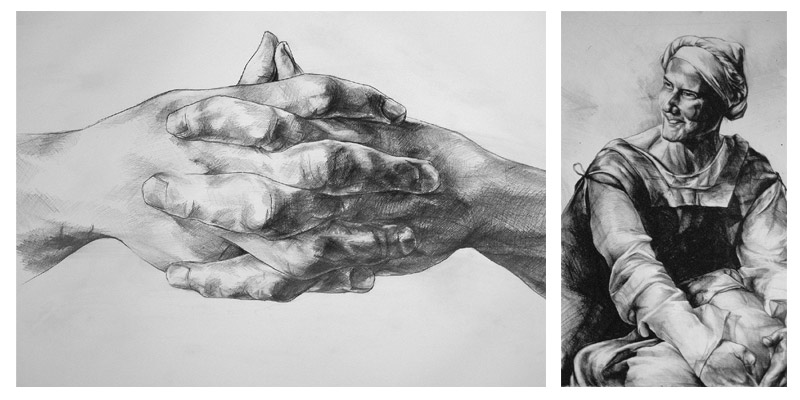
Drawing underpins all artistic pursuits. Image left, Hands, A1 pencil, image right, Hannah, A1 pencil © Jason Ruffell.






